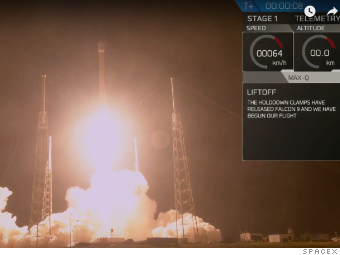
SpaceX kicked off the new year with a mystery-shrouded mission to deliver a government spacecraft, called Zuma, into orbit.
After more than a month of delays, a SpaceX Falcon 9 rocket vaulted toward the skies at 8 p.m. ET Sunday with the secretive payload. It launched from Cape Canaveral Air Force Station in Florida.
The space exploration firm, which is headed by Tesla (TSLA) CEO Elon Musk, initially scheduled the Zuma mission last November.
SpaceX gave a couple reasons for the schedule changes. At one point, SpaceX said it delayed the mission for "fairing testing." The fairing is the very top portion of the rocket that houses the payload. "Extreme weather" also slowed down the company's launch preparations.
Last week, SpaceX finally declared that both the rocket and the payload were "healthy" and ready for launch.
On Sunday, Zuma was delivered to low-Earth orbit, which is typically defined as any orbital path less than about 1,200 miles above the Earth's surface, according to NASA. Zuma's precise destination was not disclosed.
That was not the only thing kept secret about Zuma.
The spacecraft was built for the U.S. government, and it's not unusual for the government to keep information about sensitive payloads under wraps. Typically these payloads involve a military concern, such as national security, defense or surveillance.
When asked about the project in November, Northrop Grumman (NOC) -- the Virginia-based aerospace and defense company that built the Zuma spacecraft -- declined to give any details about the spacecraft or reveal which arm of the government funded it.
"The U.S. Government assigned Northrop Grumman the responsibility of acquiring launch services for this mission," the company said in a statement. "Northrop Grumman realizes this is a monumental responsibility and we have taken great care to ensure the most affordable and lowest risk scenario for Zuma."
The company declined further comment Sunday.
Because of Zuma's secrecy, SpaceX didn't live stream the entire mission. But there was still plenty for SpaceX to show off after launch.
The company executed its signature move: guiding the first-stage rocket booster back to Earth for a safe landing.
Just over two minutes after liftoff Sunday, the first-stage booster separated from the second stage and fired up its engines. The blaze allowed the rocket to safely cut back through the Earth's atmosphere and land on a pad at the Cape Canaveral Air Force Station.
SpaceX lands boosters so they can be reused in future missions. It's meant to help make spaceflight cheaper.
The Zuma launch kicked off what SpaceX hopes will be an exciting year.
The company completed a record-setting 18 launches last year, and SpaceX plans to do even more this year, according to spokesman James Gleeson.
Later this month, the company plans to debut its latest invention: the Falcon Heavy. The monstrous rocket will have three times the thrust of the Falcon 9.
Hi! I am a robot. I just upvoted you! I found similar content that readers might be interested in:
http://money.cnn.com/2018/01/07/technology/future/spacex-zuma-spacecraft-launch/
readers interested must visit it